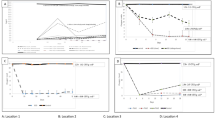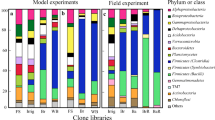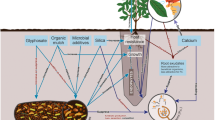Abstract
Purpose of Review
The physicochemical properties of soil that are correlated with the presence of Burkholderia pseudomallei have been reported with controversial results. The knowledge of microbes with potential antagonistic effects against B. pseudomallei as biocontrol agents is also limited. This review therefore describes the knowledge of abiotic and biotic factors correlated with the presence or absence of B. pseudomallei and the potential use of microbes as a biocontrol.
Recent Findings
The physicochemical factors in soil in unused land, rice paddies, or animal farms could identify significant factors correlated with the presence or absence of B. pseudomallei. The complex interaction of microbes and physicochemical factors may explain the uneven distribution of B. pseudomallei in soil. The potential use of bacteriophages and other antagonistic bacteria to control this lethal bacterium is discussed.
Summary
Water content and acidic pH were two physicochemical factors commonly found correlating with the presence of B. pseudomallei in soil. Bacteriophages and some antagonistic bacteria showed potential to be used as biocontrols for B. pseudomallei.

Similar content being viewed by others
References
Papers of particular interest, published recently, have been highlighted as: • Of importance •• Of major importance
White N. Melioidosis. Lancet. 2003;361:1715–22.
Inglis TJJ, Sagripanti J-LL. Environmental factors that affect the survival and persistence of Burkholderia pseudomallei. Appl Environ Microbiol. 2006;72:6865–75.
Engering A, Hogerwerf L, Slingenbergh J. Pathogen–host–environment interplay and disease emergence. Emerg Microbes Infect. 2013;2:e5.
Ajilogba CF, Babalola OO. Integrated management strategies for tomato Fusarium wilt. Biocontrol Sci. 2013;18:117–27.
Teng-hern TL, Kok-gan C, Han LL. Application of bacteriophage in biocontrol of major foodborne bacterial pathogens. J Mol Biol Mol Imaging. 2014;1:1–9.
Goodridge LD, Bisha B. Phage-based biocontrol strategies to reduce foodborne pathogens in foods. Bacteriophage. 2011;1:130–7.
Gálvez A, Abriouel H, Benomar N, Lucas R. Microbial antagonists to food-borne pathogens and biocontrol. Curr Opin Biotechnol. 2010;21:142–8.
Cooper IR. A review of current methods using bacteriophages in live animals, food and animal products intended for human consumption. J Microbiol Methods. 2016;130:38–47.
Handelsman J. Biocontrol of soilborne plant pathogens. Plant Cell. 1996;8:1855–69.
Emmert EAB, Handelsman J. Biocontrol of plant disease: a (Gram-) positive perspective. FEMS Microbiol Lett. 1999;171:1–9.
Hovick SM, Carson WP. Tailoring biocontrol to maximize top-down effects: on the importance of underlying site fertility. Ecol Appl. 2015;25:125–39.
Duffy B, Schouten A, Raaijmakers JM. Pathogen self-defense: mechanisms to counteract microbial antagonism. Annu Rev Phytopathol. 2003;41:501–38.
Vitullo D, Altieri R, Esposito A, Nigro F, Ferrara M, Alfano G, et al. Suppressive biomasses and antagonist bacteria for an eco-compatible control of Verticillium dahliae on nursery-grown olive plants. Int J Environ Sci Technol. 2013;10:209–20.
Trun N, Trempy J. Plasmids, bacteriophage and transposons as a tools. In: Trun N, Trempy J, editors. Fundamental of bacterial genetic. New York: Wiley; 2009.
Hassan M, Kjos M, Nes IF, Diep DB, Lotfipour F. Natural antimicrobial peptides from bacteria: characteristics and potential applications to fight against antibiotic resistance. J Appl Microbiol. 2012;113:723–36.
Reddy KVR, Yedery RD, Aranha C. Antimicrobial peptides: premises and promises. Int J Antimicrob Agents. 2004;24:536–47.
Abriouel H, Franz CMAP, Ben Omar N, Galvez A. Diversity and applications of Bacillus bacteriocins. FEMS Microbiol Rev. 2011;35:201–32.
Kumar A, Johri BN. Antimicrobial lipopeptides of bacilus: natural weapons for biocontrol of plant pathogens. In:Satyanarayana T, Johri BN, Prakash A, editors. Microorganisms in Sustainable Agriculture and Biotechnology. Netherlands: Springer; 2012. p. 91-111.
• Vinodkumar S, Nakkeeran S, Renukadevi P, Malathi VG. Biocontrol potentials of antimicrobial peptide producing Bacillus species: multifaceted antagonists for the management of stem rot of carnation caused by Sclerotinia sclerotiorum. Front Microbiol. 2017;8:446. Demonstrate the use of B. amyloliquefaciens as biocontrol for Sclerotinia sclerotiorum in vitro.
Palasatien S, Lertsirivorakul R, Royros P, Wongratanacheewin S, Sermswan RW. Soil physicochemical properties related to the presence of Burkholderia pseudomallei. Trans R Soc Trop Med Hyg. 2008;102:S5–9.
Ngamsang R, Potisap C, Boonmee A, Lawongsa P, Chaianunporn T, Wongratanacheewin S, et al. The contribution of soil physicochemical properties to the presence and genetic diversity of Burkholderia pseudomallei. Southeast Asian J Trop Med Public Health. 2015;46:38–50.
•• Musa HI, Hassan L, Shamsuddin ZH, Panchadcharam C, Zakaria Z, Aziz SA. Physicochemical properties influencing presence of Burkholderia pseudomallei in soil from small ruminant farms in peninsular Malaysia. PLoS One. 2016;11:e0162348. The iron, water and clay soil in the soil samples from ruminant farm in Malaysia favored the survival of B. pseudomallei.
Kanai K, Kondo E. Recent advances in biomedical sciences of Burkholderia pseudomallei (basonym: Pseudomonas pseudomallei). Jpn J Med Sci Biol [Internet]. 1994;47:1–45.
•• Hantrakun V, Rongkard P, Oyuchua M, Amornchai P, Lim C, Wuthiekanun V, et al. Soil nutrient depletion is associated with the presence of Burkholderia pseudomallei. Appl Environ Microbiol. 2016;82:7086–92. Key demonstration of this study in soil samples from the rice field of Thailand showed that the presence of B. pseudomallei was negatively associated with the percentage of organic matter, level of salinity and percentage of soil moisture.
Manivanh L, Pierret A, Rattanavong S, Kounnavongsa O, Buisson Y, Elliott I, et al. Burkholderia pseudomallei in a lowland rice paddy: seasonal changes and influence of soil depth and physico-chemical properties. Sci Rep. 2011;77:532–6.
Wang-ngarm S, Chareonsudjai S, Chareonsudjai P. Physicochemical factors affecting the growth of Burkholderia pseudomallei in soil microcosm. Am J Trop Med Hyg. 2014;90:480–5.
• Baker AL, Ezzahir J, Gardiner C, Shipton W, Warner JM. Environmental attributes influencing the distribution of Burkholderia pseudomallei in Northern Australia. PLoS One. 2015;10:e0138953. This environmental soil samples from Townsville, Australia, found that the presence of B. pseudomallei was correlated with a low gravimetric water content, low nutrient availability, high exchangeable potassium and low levels of copper, iron and zinc.
Howard K, Inglis TJJ. Disinfection of Burkholderia pseudomallei in potable water. Water Res. 2003;36:4425–32.
Kaestli M, Mayo M, Harrington G, Ward L, Watt F, Hill JV, et al. Landscape changes influence the occurrence of the melioidosis bacterium Burkholderia pseudomallei in soil in Northern Australia. PLoS Negl Trop Dis. 2009;3:e364.
Limmathurotsakul D, Wuthiekanun V, Chantratita N, Wongsuvan G, Amornchai P, Day NPJ, et al. Burkholderia pseudomallei is spatially distributed in soil in Northeast Thailand. PLoS Negl Trop Dis. 2010;4:e694.
•• Kaestli M, Harrington G, Mayo M, Chatfield MD, Harrington I, Hill A, et al. What drives the occurrence of the melioidosis bacterium Burkholderia pseudomallei in domestic gardens? PLoS Negl Trop Dis. 2015;9:e0003635. The anthropogenic manipulations common to gardens and the presence of B. pseudomallei were investigated using microcosm experiment.
Chen YS, Chen SC, Kao CM, Chen YL. Effects of soil pH, temperature and water content on the growth of Burkholderia pseudomallei. Folia Microbiol (Praha). 2003;48:253–6.
Kamjumphol W, Chareonsudjai P, Taweechaisupapong S, Chareonsudjai S. Morphological alteration and survival of Burkholderia pseudomallei in soil microcosms. Am J Trop Med Hyg. 2015;93:1058–65.
Gatedee J, Kritsiriwuthinan K, Galyov EE, Shan J, Dubinina E, Intarak N, et al. Isolation and characterization of a novel podovirus which infects Burkholderia pseudomallei. Virol J. 2011;8:366.
Shan J, Korbsrisate S, Withatanung P, Adler NL, Clokie MRJ, Galyov EE. Temperature dependent bacteriophages of a tropical bacterial pathogen. Front Microbiol. 2014;5:599.
Yordpratum U, Tattawasart U, Wongratanacheewin S, Sermswan RW. Novel lytic bacteriophages from soil that lyse Burkholderia pseudomallei. FEMS Microbiol Lett. 2011;314:81–8.
Boottanun P, Potisap C, Hurdle JG, Sermswan RW. Secondary metabolites from Bacillus amyloliquefaciens isolated from soil can kill Burkholderia pseudomallei. AMB Express. 2017;7:16.
•• Withatanung P, Chantratita N, Muangsombut V, Saiprom N, Lertmemongkolchai G, Klumpp J, et al. Analyses of the distribution patterns of Burkholderia pseudomallei and associated phages in soil samples in Thailand suggest that phage presence reduces the frequency of bacterial isolation. PLoS Negl Trop Dis. 2016;10:e0005005. The presence of bacteriophage capable of infecting B. pseudomallei may affect the success of the pathogen isolation from the soil.
Leclerc H, Sureau P. Research on bacteriophages of the Whitmore bacillus in stagnant waters of Hanoi. Bull Soc Pathol Exot Filiales. 1956;49:874–82.
• Khakhum N, Yordpratum U, Boonmee A, Tattawasart U, Rodrigues JLM, Sermswan RW. Identification of the Burkholderia pseudomallei bacteriophage ST79 lysis gene cassette. J Appl Microbiol. 2016;121:364–72. Characterisation of lysis cassette genes from bacteriophage that can lyse B. pseudomallei.
DeShazer D. Genomic diversity of Burkholderia pseudomallei clinical isolates: subtractive hybridization reveals a Burkholderia mallei-specific prophage in B. pseudomallei 1026b. J Bacteriol. 2004;186:3938–50.
Ronning CM, Losada L, Brinkac L, Inman J, Ulrich RL, Schell M, et al. Genetic and phenotypic diversity in Burkholderia: contributions by prophage and phage-like elements. BMC Microbiol. 2010;10:202.
Kvitko BH, Cox CR, DeShazer D, Johnson SL, Voorhees KJ, Schweizer HP. φX216, a P2-like bacteriophage with broad Burkholderia pseudomallei and B. mallei strain infectivity. BMC Microbiol. 2012;12:289.
Holden MTG, Titball RW, Peacock SJ, Cerdeno-Tarraga AM, Atkins T, Crossman LC, et al. Genomic plasticity of the causative agent of melioidosis Burkholderia pseudomallei. Proc Natl Acad Sci. 2004;101:14240–5.
Coffey B, Mills S, Coffey A, McAuliffe O, Ross RP. Phage and their lysins as biocontrol agents for food safety applications. Annu Rev Food Sci Technol. 2010;1:449–68.
Oliveira M, Abadias M, Colás-Medà P, Usall J, Viñas I. Biopreservative methods to control the growth of foodborne pathogens on fresh-cut lettuce. Int J Food Microbiol. 2015;214:4–11.
Labrie SJ, Samson JE, Moineau S. Bacteriophage resistance mechanisms. Nat Rev Microbiol. 2010;8:317–27.
Fu W, Forster T, Mayer O, Curtin JJ, Lehman SM, Donlan RM. Bacteriophage cocktail for the prevention of biofilm formation by Pseudomonas aeruginosa on catheters in an in vitro model system. Antimicrob Agents Chemother. 2010;54:397–404.
Spricigo DA, Bardina C, Cortés P, Llagostera M. Use of a bacteriophage cocktail to control Salmonella in food and the food industry. Int J Food Microbiol. 2013;165:169–74.
Kulsuwan R, Wongratanacheewin S, Wongratanacheewin RS, Yordpratum U, Tattawasart U. Lytic capability of bacteriophages (family Myoviridae) on Burkholderia pseudomallei. Southeast Asian J Trop Med Public Health. 2015;45:1344–53.
Farrand SK. Agrobacterium radiobacter strain K84: a model biocontrol system. In: Baker RR, Dunn PE, editors. New directions in biological control. Alternatives for suppressing agricultural pests and diseases. Proceedings of a UCLA colloquim held at Frisco, Colorado. New York: Wiley-Liss Inc; 1990. p. 20–27, 1989.
• Chowdhury SP, Hartmann A, Gao X, Borriss R. Biocontrol mechanism by root-associated Bacillus amyloliquefaciens FZB42—a review. Front Microbiol. 2015;6:780. Elucidate the interactions among the beneficial bacterium, the pathogens and the plants using B. amyloliquefaciens as a model.
Wu L, Wu HJ, Qiao J, Gao X, Borriss R. Novel routes for improving biocontrol activity of Bacillus based bioinoculants. Front Microbiol. 2015;6:1395.
Weller DM. Pseudomonas biocontrol agents of soilborne pathogens: looking back over 30 years. Phytopathology. 2007;97:250–6.
Elliott M, Shamoun SF, Sumampong G, James D, Masri S, Varga A. Evaluation of several commercial biocontrol products on European and North American populations of Phytophthora ramorum. Biocontrol Sci Tech. 2009;19:1007–21.
Koch E. Evaluation of commercial products for microbial control of soil-borne plant diseases. Crop Prot. 1999;18:119–25.
Marshall K, Shakya S, Greenhill AR, Baker GPA, Warner JM. Antibiosis of Burkholderia ubonensis againist Burkholderia pseudomallei, the causative agent for melioidosis. Southeast Asian J Trop Med Public Health. 2010;41:904–12.
Lin HH, Chen YS, Li YC, Tseng IL, Hsieh TH, Buu LM, et al. Burkholderia multivorans acts as an antagonist against the growth of Burkholderia pseudomallei in soil. Microbiol Immunol. 2011;55:616–24.
Acknowledgements
We would like to acknowledge the Higher Education Research Promotion and National Research University Project of Thailand, CHE, through the Health Cluster (SheP-GMS), Melioidosis Research Center and Khon Kean University, National Research Council of Thailand and Faculty of Medicine, Khon Kaen University, through the Targeted Research Fund. We would like to acknowledge Emeritus Professor James A. Will, University of Wisconsin-Madison, under Publication Clinic, KKU, Thailand.
Author information
Authors and Affiliations
Corresponding author
Ethics declarations
Conflict of Interest
The authors declare that they have no conflicts of interest.
Human and Animal Rights and Informed Consent
This article does not contain any studies with human or animal subjects performed by any of the authors.
Additional information
This article is part of the Topical Collection on Melioidosis and Tropical Bacteriology
Rights and permissions
About this article
Cite this article
Sermswan, R.W., Wongratanacheewin, S. Physicochemical and Biological Factors of Soil and the Potential Use of Antagonistic Microbes for Biocontrol of Burkholderia pseudomallei . Curr Trop Med Rep 4, 192–198 (2017). https://doi.org/10.1007/s40475-017-0125-3
Published:
Issue Date:
DOI: https://doi.org/10.1007/s40475-017-0125-3




